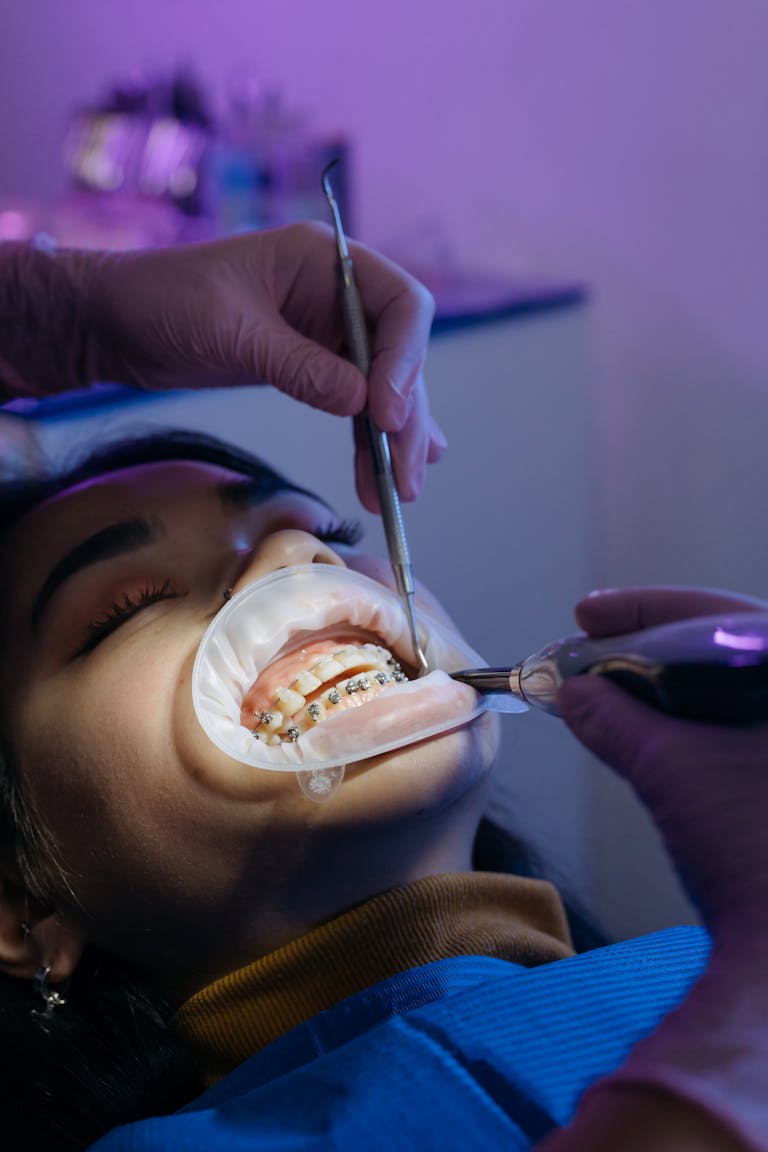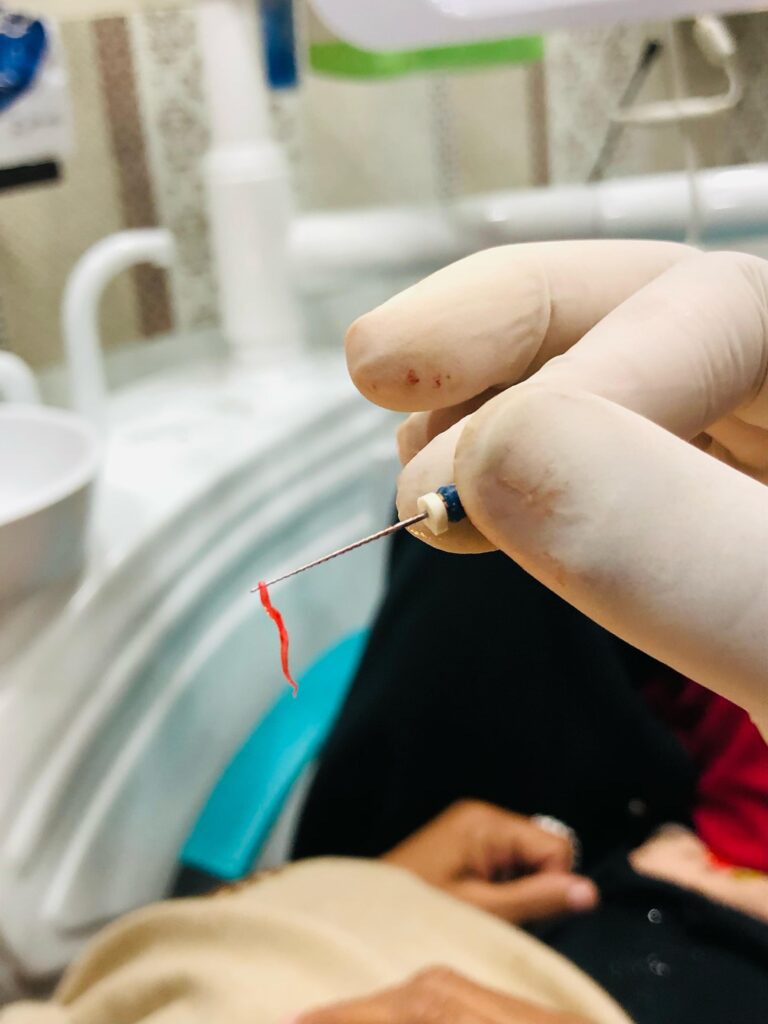Aesthetic tooth bonding is an immediate, affordable solution that can repair and beautify short or crooked teeth. It’s the best way to a more beautiful smile!
Dentists in the U.S. Use a tooth-colored resin to match the shade of real teeth, then shape it to make teeth look longer and more even. The bonding process is fairly straightforward, and most patients complete it in a single appointment.
It doesn’t require anesthesia or drilling, making it seem simple for everyone. Bonding is ideal for front teeth, the teeth where appearance is often the biggest concern.
Angelenos are drawn to this choice for its more natural appearance and immediate solution. The next part covers how bonding works, what you can expect, and tips to keep your new smile looking fresh.
What Is Aesthetic Tooth Bonding?

Aesthetic tooth bonding is a cosmetic restorative procedure that improves the appearance of teeth. Your dentist can apply this tooth-colored resin to lengthen short teeth, fill in gaps between teeth, or repair broken chips and cracks.
Since the resin is tinted to match your own teeth, the resulting changes are indistinguishable from your existing teeth. Because of its ease and affordability, this form of bonding is widely used. It fills many purposes—from increasing length to re-establishing color and form.
Bonding Basics Explained Simply
The bonding process itself is very simple. First, the dentist lightly scrapes the tooth’s surface and applies an acidic solution to make the bonding material adhere better.
Next, the dentist selects a resin color that matches your teeth and molds it to conform perfectly. Then a special blue light is used to harden the resin in just a few seconds.
The dentist will then trim, shape and polish the new surface so it’s a perfect match to your smile. All of this occurs during a single appointment, frequently in under an hour. The majority of patients experience minimal or no discomfort, and you return to your normal activities immediately afterwards.
The Special Resin We Use
The dentists on our team use a special formula which includes that same mix of plastic and glass particles. This helps in mimicking a natural tooth which is more translucent than opaque.
High-quality resins will last for many years with regular brushing, flossing, and regular dental check-ups. The resin is then expertly sculpted and buffed to create a flawless replication of natural enamel.
As such, the majority of individuals won’t even be able to tell where the bonding is done.
How It Differs From Veneers
Compared to veneers, bonding is less invasive and a lot faster. Veneers require additional tooth preparation and are more expensive.
Bonding is best for minor corrections, but veneers work better for more extensive adjustments. Bonding is typically completed in just one appointment.
Why Bonding Works for Short Teeth
Tooth bonding is a highly effective and largely favorable option for those who want to repair short teeth and improve their smile. This approach is pretty straightforward, quick and works with the lifestyles of so many individuals. In vibrant cities and metro areas, including Los Angeles, residents value a beautiful smile.
With an easy procedure and instant results, it’s no surprise that bonding is one of the most popular cosmetic dental treatments! Since the procedure utilizes composite resin, your dentist can closely match the material to the natural tooth. This durable compound can paint, lengthen, repair chips, or fill gaps beautifully.
Not only does bonding improve the aesthetic appearance of the teeth, but it preserves the majority of the natural tooth. Here’s why bonding is such a perfect solution for short teeth and how it provides truly transformative, dependable results.
1. Adding Length Naturally
Bonding allows dentists to add length to short teeth without significantly shortening the original tooth. The composite resin is placed directly onto the tooth in layers. This process makes certain it fits in perfectly with the rest of your smile.
This creates less discomfort because there is no requirement for crowns or veneers, which usually require additional buffing and preparation. Patients are often out of the dental office within one hour. Their smiles look longer and more natural!
Because color-matched resin is used, no one will ever be able to tell that any work was done. That’s why those who’ve taken the plunge regularly report experiencing an immediate confidence high. The transformation is immediate and 100% natural in appearance.
2. Improving Your Tooth Proportions
A pretty smile is about the right shape and balance—not just shade. If short teeth create an imbalance in the entire smile’s relationship to the face, bonding can help restore balance and harmony. Bonding is an effective procedure to create balance in these uneven areas.
When this strategic addition of resin is made, dentists can create the illusion that your teeth are more uniform in size and shape. This creates a more harmonious appearance to the smile that’s more proportionate and natural to the overall facial structure.
If your upper teeth look too short or jagged, bonding might be the solution. It smooths and shapes them for a more natural look among all your teeth. By balancing the overall appearance of the face, even with this small adjustment, most people find it to be a more aesthetically appealing choice.
3. Creating a Fuller Smile Line
Occasionally short teeth or gaps can create a smile line that appears pinched or fractured. Bonding can quickly and easily fill these gaps, building out the edges of the teeth until they match up with the rest. This helps provide a fuller look.
The teeth get a smooth transition from one side of the mouth to the other. The impact is noticeable—smiles appear healthier and more full. A complete smile improves the shape of your lips and draws attention to your teeth.
Most patients find that this is a much cuter and more welcoming appearance. For people who feel self-conscious about small or uneven teeth, this one-step fix often makes a big difference in how they feel about their look.
4. Quick Results, Big Smile Impact
Which brings us to one of the most popular reasons why people love bonding so much—the quickness. Since bonding is easy to apply, the dentist can usually do the work in a single visit. Usually, it’s under an hour per tooth!
There’s minimal to no recovery period following the appointment, so patients can return to their normal routine quickly. This makes it an ideal option for those who have a hectic lifestyle. It works wonders for patients who want to skip weeks of waiting for cosmetic results.
Immediately following the procedure, you’ll be able to see the difference in shape and length of your teeth. This change makes a dramatic difference in your smile immediately! This quick transformation is a major appeal to urban living, where life moves at a much faster pace and time can be hard to come by.
5. A Less Invasive Lengthening Option
Bonding preserves more of the natural tooth, compared to crowns or veneers that require additional drilling or shaping. As there is no surgery or incisions involved, recovery is much simpler. If you’re looking for a cosmetic improvement but are fearful of extensive dental procedures, bonding is a great option.
It’s less invasive, meaning it’s less risky and a lot more comfortable! There’s a low risk of pain or swelling. For the majority of people, life goes back to normal the minute they leave the appointment.
Its non-surgical nature makes it accessible for a wider range of patients to consider. This includes people who may not be eligible for more advanced options.
6. Fixing Minor Enamel Issues Too
Short teeth frequently are accompanied by chips, cracks, or worn edges. Bonding is a great solution to hide these imperfections while simultaneously increasing the length of teeth. Not only does the resin act as a protective cover, but it works to fill in any damage.
This two-in-one combo makes the tooth stronger while still whitening. This means bonding isn’t purely cosmetic—it prevents the tooth from more enamel erosion. Patients experience two wonderful benefits at once – a more beautiful smile and healthier teeth.
This strength is particularly important in helping them keep their natural teeth healthy as they age.
7. Balancing Your Overall Smile Look
Bonding can help teeth match each other and blend with old dental work. If you have a combination of crowns, fillings, and natural teeth, bonding is your best friend. It really makes the entire appearance come together.
Any good dentist will be able to shape and color the resin so that it seamlessly fits what’s already there. This customized approach achieves a more natural result and just less “done.
When your overall smile look is nicely balanced, individuals will feel more comfortable and willing to smile with teeth exposed.
The Bonding Process Step-by-Step

Cosmetic tooth bonding for short teeth involves a distinct dental bonding procedure, emphasizing harmony between the dentist and patient. Each step of the teeth bonding process is designed to prioritize your comfort, keep you informed, and deliver natural-looking results.
Your First NYC Smile Chat
Your first visit isn’t just another dentist appointment. It’s an open dialogue where the patient and dentist both express their priorities to establish the best objectives. This Smile Chat allows the dentist to understand the specific goals of the patient and determine if bonding is appropriate.
During your appointment, your dentist will thoroughly examine your teeth, identify any issues, and discuss how to address them. Transparent communication helps ensure both parties understand what to expect and feel respected.
Gentle Tooth Surface Preparation
Once both sides are ready to proceed, the dentist prepares the tooth. This segment is fast and fun. The dentist or dental hygienist cleans the surface of the tooth to remove stains and plaque.
After that, a gentle solution creates a very slight texture on your tooth’s surface. This is all done to make the bonding stick extra well. It’s a step that most patients consider a breeze, with zero pain and drama.
Applying and Shaping the Material
Next, the dentist applies a tooth-colored resin to the tooth. This is where the artistry and in-depth skill comes on. The dentist then shapes the resin to mimic the appearance of surrounding teeth and ensures the color is a perfect match.
A steady hand and a trained eye ensure the new contour does not stand out, but rather is integrated into surrounding structures and complements the patient’s unique facial anatomy.
Hardening and Polishing Your New Smile
A blue light hardens the resin quickly. Next, the dentist hardens and polishes the new tooth, making it shine and smoothing its surface.
Lastly, a final check ensures that the new smile appears proper and that the patient is satisfied.
Is Bonding Right for Your Short Teeth?
Deciding if bonding for short teeth is right for you requires an in-depth analysis of your unique dental situation. This choice is ideal for minor tooth repair. Its effectiveness depends on how short your teeth are.
Bonding is a relatively fast and simple procedure. You will enjoy results after only one visit with little tooth preparation. Some cases may be too severe for bonding to correct. Consult with your dentist first. Always begin with an in-depth conversation with your dentist to determine what’s best for your smile.
Who Benefits Most from Bonding
Bonding is most effective for people who have small chips, slightly shortened teeth, or teeth that appear irregular. If you’re looking for a quick solution, bonding will provide your smile with a significant improvement in just one easy appointment.
Patients enjoy it because it is drill and shot-free. For example, someone who chipped a front tooth or has a tooth that is just a bit shorter than the rest could see a big change after one visit. Because the composite resin is colored to match your natural teeth, the appearance is very discreet.
When Another Option Is Better
If your teeth are extremely short or badly decayed, bonding might not be the best choice. These scenarios may justify using crowns or veneers, which can be more durable or aesthetically pleasing in the long run.
For an individual with severe fissures or large spaces, other alternatives might be more durable. So make sure to ask your dentist about all options before you make a decision.
Thinking About Your Bite and Habits
If you suffer from bruxism or other habits like ice chewing, cosmetic tooth bonding can chip or stain more easily. If you tend to clench or grind your teeth, let your dentist know so they can work with you on a suitable dental bonding treatment.
Assessing Your Gum Health First
Healthy gums are essential for the success of cosmetic tooth bonding to remain intact long-term. Gum disease can compromise the dental bonding procedure and how long the solution lasts.
Bonding vs. Other Short Teeth Fixes

Compared to alternatives, dental bonding is a straightforward and budget-friendly solution for short teeth. Many in Los Angeles and beyond choose bonding because it handles small chips or size concerns fast and with little fuss. There are alternatives, like crowns, veneers, or gum reshaping.
Bonding is an easier, less expensive fix. Bonding is relatively affordable, costing $300 to $600 per tooth, and it’s a quick procedure, requiring only 30 to 60 minutes per tooth. Unlike other short teeth fixes, most patients leave with a new smile in just one visit.
Bonding Compared to Porcelain Crowns
Crowns require more time and tooth preparation. When dentists have to shave down the tooth, it’s more invasive and the cost rises, usually $1,100 to $3,000 per tooth. Crowns are more durable, lasting for decades in some cases, and can handle such vigorous use as chewing and grinding.
Beyond that, they have the added benefit of appearing exactly like natural teeth due to the material porcelain. Bonding, in comparison, is less abrasive on the tooth and accommodates subtler repairs. It will likely require a touch-up or replacement in 5 to 10 years, but this can be easily redone.
The speedy remedy and accompanying lower cost make bonding, for many, the clear choice.
Bonding Compared to Gum Reshaping
While bonding repairs the tooth, gum reshaping alters the gum line. It’s most effective when the gums are covering an excess of tooth. Bonding adds length to the tooth.
It works great for teeth that are too short because of their shape, not just due to gum overgrowth. Most people choose to do a little of both to achieve a nice, even appearance. Bonding by itself is best for people who have healthy gums and minor tooth length problems.
Making the Best Choice for You
Each fix, including cosmetic tooth bonding and dental bonding treatment, has its advantages and works best for different needs. Communicating openly with a dentist can help balance cost, aesthetics, and future goals, ensuring the best dental care for your smile and lifestyle.
Caring for Your Newly Bonded Teeth

Aesthetic tooth bonding can significantly improve the appearance of short, unevenly sized teeth, creating a more balanced smile. To help maintain the results of your cosmetic teeth bonding, practice the following care tips daily. Proper oral hygiene and daily practices are crucial for preserving the quality of your newly bonded teeth. Routine dental bonding treatment checkups will also help keep them looking good. Here’s a look at everything you need to know to safeguard your fresh smile.
Daily Habits for Lasting Results
Caring for your new bonded teeth begins with simple daily oral care. Be sure to use a soft-bristled toothbrush and non-abrasive toothpaste when brushing to avoid damaging the bonding material. Since hard bristles or gritty pastes will scratch the bonding material, you should choose a soft brush and non-abrasive paste.
When flossing, take your time and have a soft touch when you’re around the bonded areas. Some wear can be minimized by avoiding habits such as nail biting, ice chewing, or using your teeth to open items. All of these activities can wear down the bonded areas and reduce their longevity. Most patients experience their teeth feeling slightly strange or sensitive initially, but this quickly subsides.
Foods and Drinks to Be Mindful Of
Bonded teeth can become fast stained if exposed to certain foods or drinks. Coffee, tea, red wine, and dark sodas are common culprits of staining when consumed regularly. Sticky candy, crunchy nuts, and snack foods will all stress the bonding as well.
Being mindful to limit these foods and drinks makes all the difference. Acidic or sugary foods, such as citrus or soda, can damage the bonding over time. A nutritious diet rich in water, fruits and vegetables helps maintain healthy teeth.
Why Regular NYC Dental Visits Matter
Routine NYC dental visits—twice a year—ensure that bonded teeth remain as healthy as possible. Regular dental cleanings catch stains and tartar that brushing alone can’t get. Regular dental exams allow us to catch small issues early, before they become much bigger (and more expensive) problems.
When maintained properly, this regular regimen can extend the longevity of bonded teeth from 5 to 10 years or longer.
Bonding and Your Tooth Enamel
Reducing the appearance of short teeth Tooth bonding provides a relatively simple fix for improving the look of stubby or worn-down teeth. Here’s how bonding can contribute to strong enamel. Your tooth enamel, the outer layer of teeth, is your body’s hardest substance. It protects the teeth from daily wear and tear, acid exposure, and extreme temperatures like hot and cold food.
Enamel erosion can make your teeth appear stunted, brittle, or more susceptible to discomfort. Bonding delivers a repair requiring minimal drilling and reshaping. Dental bonding is often accomplished with a sturdy tooth-colored resin that adheres directly to your enamel surface. Since only a small portion of the tooth is prepared, the majority of your enamel remains intact.
The bonding process is typically completed in a single office visit, and usually only takes 30 to 60 minutes per tooth. This flexible option is a perfect fit for Angelenos and other busy city dwellers. With barely any effort, they can get quick results that endure.
How Bonding Can Protect Enamel
Since bonded teeth aren’t covered with enamel, the bonding material protects the tooth underneath, similar to a shield. This creates a smooth coating over susceptible areas. This prevents sensitivity to temperature changes, such as hot and cold foods and drinks.
For those who suffer from sensitive teeth, bonding can provide tangible comfort. It protects additional enamel from eroding, as the bonding resin relieves some of the wear and tear on the natural tooth.
Addressing Existing Tooth Enamel Wear
If enamel is already worn, bonding can fill in thin or rough spots. This can repair chips or cracks in the enamel, or discoloration from aging, making your teeth appear younger and more vibrant. Repairing worn enamel with bonding will increase the appearance of length and evenness of the teeth.
Addressing existing tooth enamel wear and avoiding enamel erosion today helps prevent minor concerns from becoming major dental issues tomorrow.
Finding Bonding Expertise in NYC
For folks in New York City thinking about cosmetic teeth bonding for short teeth, finding the right cosmetic dentist matters a lot. The dental bonding procedure is a very conservative treatment that enhances your appearance by reshaping your smile or repairing issues such as chips, cracks, or gaps.
How much does dental bonding in NYC cost? Dental bonding usually ranges from $100 to $400 per tooth. Since it is placed for a period of three to ten years, selecting the right dentist is important in obtaining a successful outcome.
To get the most out of the dental bonding treatment, patients must do their research and find dentists with special expertise in cosmetic dentistry. Since many NYC practices advertise their specialties on their websites, it is relatively easy to identify those with relevant, concrete experience.
Because of this, local reviews and patient testimonials are extremely valuable. Individuals excitedly post photos of their trips, how long the teeth bonding process took (typically 30 to 60 minutes per tooth), and how comfy they were throughout the bonding appointment.
What Makes a Great Cosmetic Dentist
The best cosmetic dentists will make themselves known by providing visible, distinct before-and-after shots and setting up thoughtful communication. An excellent portfolio demonstrates the cosmetic dentist’s work in achieving the perfect color and shape with composite resin so that the bonding appears natural.
When a dentist makes time to listen, explain each step of the process, and regularly check on the patient’s comfort level, it establishes trust.
Why Experience with Bonding Matters
Like dentists with a steady hand at bonding. They adeptly handle difficult situations, like having to match the color of stubby teeth, or utilizing a layering technique to create an authentic look.
They stay current on practices and techniques, improving the durability of the bonding long-term. Their expertise goes a long way to spare headaches and to fewer need for follow-up visits.
Looking at Past Smile Transformations
Viewing actual photos from other patients’ outcomes allows individuals to feel more confident going through the dental bonding procedure. Looking at past smile transformations to see how cosmetic teeth bonding repaired chips, filled gaps, or matched existing teeth can provide a realistic picture of what bonding can achieve.
Conclusion
Aesthetic tooth bonding provides shorter teeth with a fast, easy enhancement. That’s why so many people in NYC choose aesthetic tooth bonding to get a polished, natural appearance with minimal invasion. Instead, your dentist hand shapes the resin, shade matches it to your other teeth, and completes the work in a single visit. No drills, no lateness, no fuss.
Not only do you enjoy your meal and conversation in an improved smile almost immediately afterwards, stay diligent with your oral hygiene, avoid chomping on ice, and make regular visits to your dentist—these three steps will help you stay on top of your bonding. When done right, bonding can be a pretty big game changer for so many people. Have short teeth and looking for a quick solution? Contact a cosmetic dentist near you and inquire whether bonding is suitable for your desired results.
Frequently Asked Questions
How does tooth bonding make short teeth look longer?
Cosmetic tooth bonding lengthens the edges of short teeth using composite resin, providing a longer, more uniform appearance. The results of this dental bonding treatment are both instant and natural in appearance.
Is tooth bonding safe for my tooth enamel?
The dental bonding procedure is safe for my tooth enamel, as it typically involves minimal to no enamel removal, ensuring that your natural teeth remain healthy and strong.
How long does aesthetic bonding last on short teeth?
Caring for cosmetic teeth bonding is essential; with good oral hygiene care and maintenance, dental bonding can last from 3 to 10 years. Avoid biting hard things and keep up with routine dental visits to ensure your smile aesthetics remain intact.
Can bonding fix just one short tooth?
Correct, you will not be disappointed! If you have one or a few short teeth, cosmetic tooth bonding is ideal to even out the appearance of your smile.
Will my bonded teeth stain easily?
As with other cosmetic dentistry treatments, cosmetic teeth bonding can be susceptible to staining over time — especially from coffee, tea, or tobacco use. Just brush daily and stop by your local NYC dentist for dental bonding treatment touch-ups when necessary.
Is tooth bonding painful?
Is tooth bonding painful? No, the dental bonding procedure is typically pain-free. In most cases, no anesthesia is required, and the cosmetic bonding treatment is completed quickly and comfortably.
Where can I find a trusted bonding specialist in NYC?
Find a cosmetic dentist in NYC who has excellent reviews and a long track record of providing cosmetic tooth bonding and dental bonding treatments. You want local experts who can produce the finest, most natural results.





